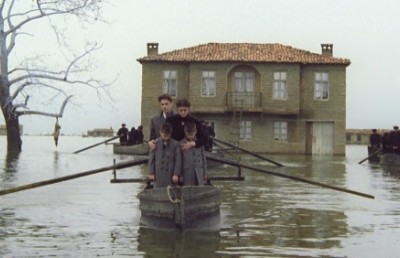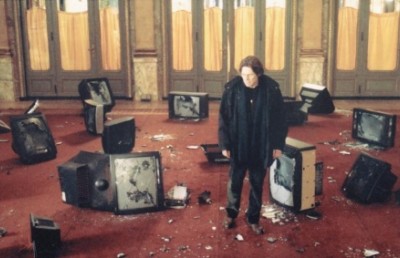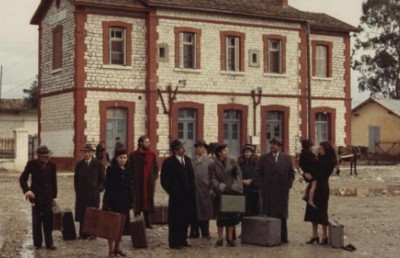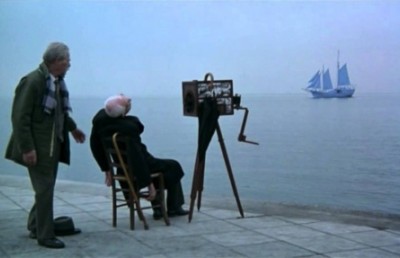The Suspended Step of the Stork: Theo Angelopoulos among the Greats
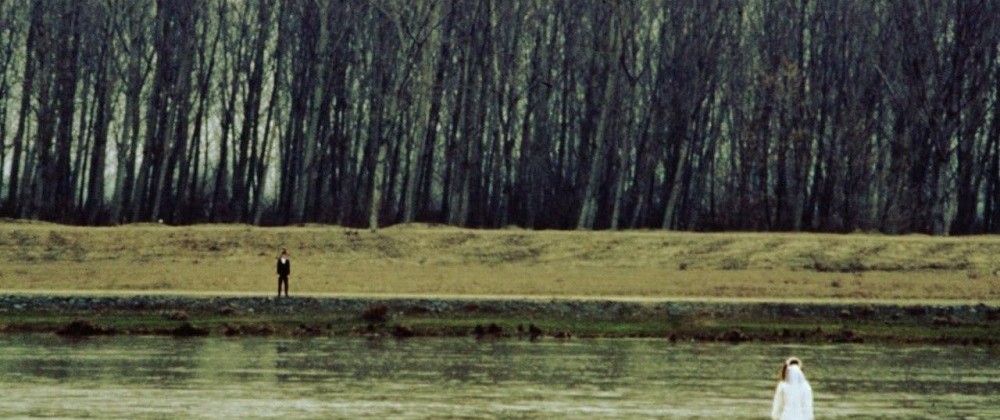
The Suspended Step of the Stork marks an important moment in the career of Greece’s preeminent auteur, Theo Angelopoulos (1935-2012). This is the film in which he solidified his measured mise-en-scène, long take, long shot style, four years before his most famous International success, Ulysses’ Gaze (1995). Yet Angelopoulos, whose every film contains isolated moments of visual sophistication, remains, in my mind, a notch below the great artists to whom he bears some superficial resemblance and who he has gone on record as saying have influenced him: Andrei Tarkovsky, Orson Welles, Kenji Mizoguchi, Michelangelo Antonioni, and Miklos Jançso. Although his films employ a similar rigorous formal control as some of these directors, his films do not consistently stir emotions and create magic in the sense of these artists. David Bordwell may have said it best in his book Figures Traced in Light (2005), when he wrote that he sees him “as more a synthesizer than an innovator.” (pg. 141) 1
The Suspended Step of the Stork bears the stamp, interestingly enough, of Tonino Guerra, an Italian screenwriter with an impressive track record. One can make a case for Guerra as an auteur in that he has written a large number of films where the emphasis is not on narrative, but on a metaphysical/spiritual quest or voyage: L’Avventura, La Notte, Identificazione di una donna, Deserto Rosso, Zabriskie Point (Antonioni), Nostalghia (Tarkovsky), Landscapes in the Mist, The Suspended Step of the Stork (Angelopolous).
With Stork, we have a poetic treatment of one of the 20th century’s most powerful social and political images: the border (or frontier). And Angelopolous treats it in one of the world’s most complicated regions, the Balkans, where geographical, political, and religious divisions run as far back as the Ottoman Empire (1300-1922), and continue to this day (as treated by Alain Chouinard in his essay in this issue). The “border” here is that separating Albania from Greece, although Angelopoulos also treats it in a figurative sense (the border separating the present from the past, separating aspects of one’s own identity, as in the case of Marcello Mastroianni’s character). The titular step comes from two bookend scenes. In the first, a Greek colonel walks along a bridge linking the two countries and stops right at the frontier line. In the distance we see rifle-toting Albanian guards. The colonel holds his right foot in the air hovering above the line. He says, “Greece ends at the blue line. If I take one more step I will be somewhere else, or die.” At the end of the film the Greek television reporter repeats this gesture (as does the symbolic journey, which both the mythical Ulysses figure played by Marcello Mastroianni and the journalist take). This sense of repetition, of history repeating itself and the journey commencing once again, is, in one sense, also the film’s source of hope.
The journalist (played by Gregory Karr) and his television film crew are apparently reporting a human interest story on a small village community just inside the Greek border, an area that has become known as “the waiting room” because of the thousands of illegal refugees – Kurds, Turks, Albanians, Poles, Romanians, Iranians – who have made this their temporary home as they wait for the last border they have to cross before arriving ”home”. They have been waiting so long that this home has become a mythical place, a state of mind rather than physical place. But the journalist’s attention becomes divided when he sees an elderly man, Mastroianni, selling fish at the street marketplace. This figure, we soon learn, looks and sounds uncannily like a once promising Greek politician who one day walked away from a formal political address and was never seen again. The journalist carries with him a book this man wrote, Despair at the End of the Century, which sports a younger picture of the author. He tries the usual channels, contacting his ex-wife (Jeanne Moreau), police files, etc., and finally the man himself. But Angelopoulos maintains the man’s mystery and enigma right up to the end, when we find out that he has once again disappeared, with people claiming to have seen him departing in completely different directions. The last time we see him is by a dirty, polluted shoreline. The journalist plays him an audio tape of the politician’s voice given to him by his ex-wife Moreau. He hardly takes notice and instead walks along the water, bent over, looking for fish to trap. There is a young boy, who may or may not be his son, who we earlier hear engaged in a story with Marcello. He asks him to tell him “the story” again. With the journalist present, Marcello recounts a story called “the great migration” about a group of people who will gather at the Sahara desert and collectively soar into the sky on the string of a kite in search of a new planet (a story which may be an hommage/reference to Miracle in Milan (1951, Vittorio De Sica), the classic of Italian neo-realism which ends with the poor riding brooms up into the heavens). The boy asks him how it will end, but Marcello remains silent. In the end, this boy tells the reporter that he saw Marcello, suitcase in hand, walking over water. The people in his migration story are in effect the thousand of stranded refugees who, like the poor in Miracle in Milan, must eventually move on across new frontiers, new borders, in search of somewhere they could call home. Whether this place will ever exist is uncertain. But the will to continue the journey must.
The film begins with a long take of helicopters circling over the corpses of Asian refugees found floating on the water: human bodies upon a body of water, itself formless, without territorial division (these images are eerily prescient of the current mass of refugees on the borders of various Balkan states). The water, the Mediterranean Sea, symbolizes the pathway to new lands, new homes, and, hopefully, peace and safety. The sight of the dead refugees floating on the water is especially poignant because borders and frontiers are not so easily drawn on water, and when drawn, call attention even more to their arbitrariness. In fact this may be one reason why many of the film’s key scenes take place near, in, or around water. An orthodox wedding takes place between a Greek bride and an Albanian groom. The only hitch is that the two wedding parties stand several hundred feet apart, divided by a body of water. The final shot of the film sees the reporter standing at the edge of the Greek shoreline and the camera begins to crane backward away from him over the water toward Albania. When we last see Marcello, he is again bent over, walking along the water and hunting for fish. And, as the boy tells the reporter, he last saw Marcello walking over water.
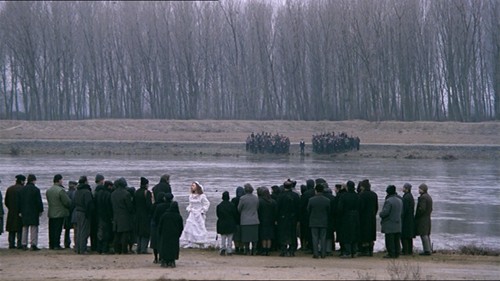
A Wedding from afar
The famous final shot is surely one of the most amazing in Angelopoulos’ work, and an example of the unique majesty and emotional power of the long take, when in the right hands. The reporter is standing on a street and looks up and away off-screen. The camera pans right to reveal, incrementally, a series of workers (fifteen in all), all dressed in yellow, climbing to the top of tall telephone poles to reconnect the electrical wiring that will, as Marcello told us earlier, re-establish contact across the border. The camera is far enough to maintain all fifteen poles in frame. The journalist stops amidst the poles, creating a striking vertical composition. He then turns and begins to walk toward the river that separates the two Balkan states. While he walks toward the river, the camera begins its track back over the water. The shot resonates with both implicit and explicit meaning. Most obviously, the workers (on wires up high in the sky like the people in the Migration Story) point toward hope with the reconnected communication lines. But their position up high on the poles recalls, quite clearly, the image of Christ who died on the cross in sacrifice for our sins. There is also a Christ reference in the boy’s description of seeing Marcello “walking on water”. But writer Andrew Horton points to another meaning that may be less obvious to those not well versed in Orthodox religion.
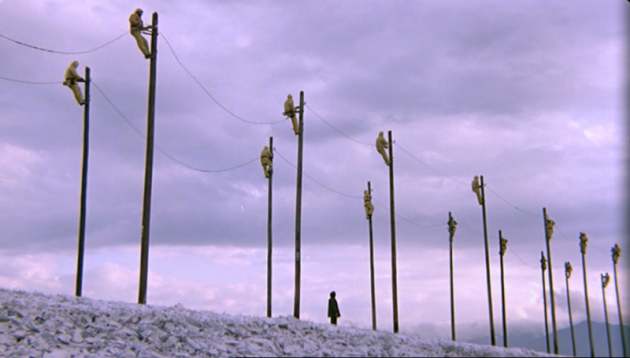
Horton writes:
And beyond the image of the crucifix, for those in the Orthodox tradition there is another historical image evoked: the stylites, those religious figures, male and female, who dedicated themselves to God by sitting on poles or columns in isolation for up to thirty years or more. 2
As I noted at the start of this piece, Angelopolous is a director worthy of great praise but one who, in my estimation, falls short of the master list. His greatest claim is surely his rigorous use of the long take camera style, yet his great sequence shots, while amazingly choreographed and often wonderfully poetic, fail to consistently generate the sense of magic one finds in the sublime long takes of Tarkovsky, Mizoguchi, Dreyer, Jançso, or Sokorov. In the works of these directors, one gets the sense that there is always something happening to move you emotionally or intellectually, even when there doesn’t seem to be any progression. One could say that in comparison to these figures, Angelopoulos engages his style in a more social or political context, but this would be unfair and, in some cases (Mizoguchi, Jançso), untrue. If we use Stork as an example, it is obvious that the text is pointedly political; but the film does not engage issues in a political way, but rather in a metaphysical-existential way. We learn nothing about why these refugees are here. Or why they have not been mobilized by the Greek government. So with Angelopoulos there are moments when his sequence shots are not engaging in either sense —social-political or metaphysical-existential— and, when this is the case, they call attention to their machination. To quote Bordwell, “The protracted image outruns its denotative and symbolic aspects, striving instead for both emotional expressivity and formal abstraction” (p. 176).
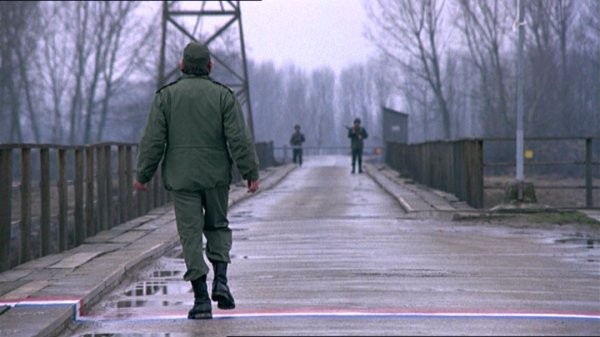
Teetering between two lands
Another point in this regard is that Angelopoulos’ long take style, when examined closely, appears less original than the styles of those noted above. His seems more like a compendium/continuum style/approach, borrowing from great masters and adding a personal touch here and there, rather than marking a clear and unadulterated break. Bordwell outlines Angelopoulos’ contributions to the 1960s modernist “de-dramatized” filmic space (Antonioni, Godard, Ackerman, Duras, etc.) as formal traits predicated on the extensive use of extreme long takes with long and extreme long shots and choreographed spaces. Bordwell notes Angelopoulos’ use of three-quarter dorsality, where characters are set almost completely with their backs to the camera, which places as much if not more emphasis on the sets, planimetric framing, with “the background resolutely perpendicular to the lens axis” and characters placed in front of a wall or blocked background, or with horizontal architectural lines of people and landscape stretching across the widescreen frame. These are abetted by lateral and diagonal/lateral tracking and panning shots which recede to reveal new information, and “recessional perspective to diminish our view of salient information….” (p. 162-179). These ”tweaks” apart, many of Angelopolous’ striking moments create a sense of déjà vu and can be traced to other filmmakers. For example, there is a wonderful lateral tracking shot in The Suspended Step of the Stork that moves left-to-right along a string of boxcars each housing a different culturally identifiable refugee family. A similar left-to-right track appears in Bela Tarr’s Damnation (1987), with the camera passing by a row of windows in which we see standing and staring different cultural and ethnic groups of people. The image of Marcello bent over and wading in the water recalls a similar moment from Tarkovsky’s The Sacrifice (1986). The mass choreography of black-dressed men and women running toward the river in the wedding scene recalls countless sequence shots from Miklos Jançso [which can be traced further back to Pietro Germi’s The Way of Hope (1949)]. And the post-wedding dance between father and daughter in the village square, with its diegetic accordion music and street café light source, recalls Fernando Solanas’ South (El Sud) (1985).
In a more general sense, Stork is reminiscent of both Tarkovsky’s The Sacrifice and (mainly) Nostalghia (1982). In Nostalghia, we have a transplanted Russian musicologist and poet in Italy doing research on an 18th century Italian composer. Like the musicologist in Nostalghia, Stork’s reporter is a stranger in a strange land, and the experience causes him to look both within himself and evaluate the meaning of his work. And also like the Tarkovsky protagonist, the reporter becomes sidetracked from his original quest by an interest in an enigmatic character who has withdrawn from society. The similarity to The Sacrifice (along with the one noted above) is in the relationship between the young boy/son and the father figure. At the end of Stork, when the father figure to the boy disappears once again, the boy wonders why he never told him how the story ended. The reporter replies, “Maybe because he wanted you to finish the story.” This is similar to the end of The Sacrifice, where the father also “disappears” (seemingly crazy, he is driven away to a sanatorium), but the transference (changing of the guard) is made to the boy/son in the form of the “word” (the boy regains his speech).
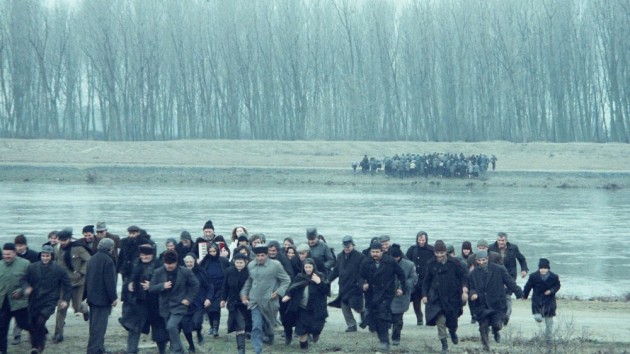
In any case, Angelopolous belongs to a once rare breed of film stylists that has grown considerably over the last thirty or so years: directors whose pacing and sense of movement is appreciably slower than most (and in some cases, slower than life as we feel it). Where once there was only Carl Dreyer, Orson Welles (at times), Yasijiro Ozu, Kenji Mizoguchi, and Robert Bresson, now we have (or have had) Miklos Jançso, Andrei Tarkovsky, Satyajit Ray, Michelangelo Antonioni, (late) Jean-Luc Godard, Lars Von Trier, Alexandr Sokurov, Abbas Kiarostami, Tsiang Ming-Liang, Bela Tarr, Raymond Depardon, Zhang Ke Jia, Hou Hsaio-Hsien, and Apichatpong Weerasithakul, to name only the most obvious or famous. Where most filmmakers dilute and contract time to the vicissitudes of action and narrative, speeding up reality and eliminating all that isn’t pragmatic and pertinent, these latter filmmakers prefer to “thicken” singular events and allow time to ruminate and contemplate images and events (less plot points, longer takes, less kinetic movement, less dialogue). Unfortunately, most viewers find such an approach difficult simply because the pacing goes against the grain of contemporary image and storytelling fabrication. But then again great art has always gone against the grain….and in this regard, with all the recent talk of the (blink and you may miss it) death of celluloid and spread of cinema viewing across all form, big and small, of screening venue, Angelopoulos remains a Theatrical director. Even Quentin Tarantino, with his recent film The Hateful Eight (2015), understands the value of the big screen experience. As Bordwell notes, with his penchant for long takes and long and extreme long shots, “He is one of the last directors to design his images specifically for the theatre screen” (p. 160).
Bibliography
Bordwell, David . Figures Traced in Light: On Cinematic Staging. Berkeley, Los Angeles, London: University of California Press, 2005.
Horton, Andrew. The Films of Theo Angelopoulos: A Cinema of Contemplation. Princeton, New Jersey: Princeton University Press, 1997.
Notes
- Bordwell also expresses “divided attention” for Angelopoulos’ works and points to four Angelopoulos films as his masterpieces, Alexander the Great (1980), Voyage to Cythera (1984), Landscape in the Mist (1988), and _The Suspended Step of the Stork_(1991). (p. 141) ↩
- The Films of Angelopolous: A Cinema of Contemplation, 1997, p. 177. ↩



